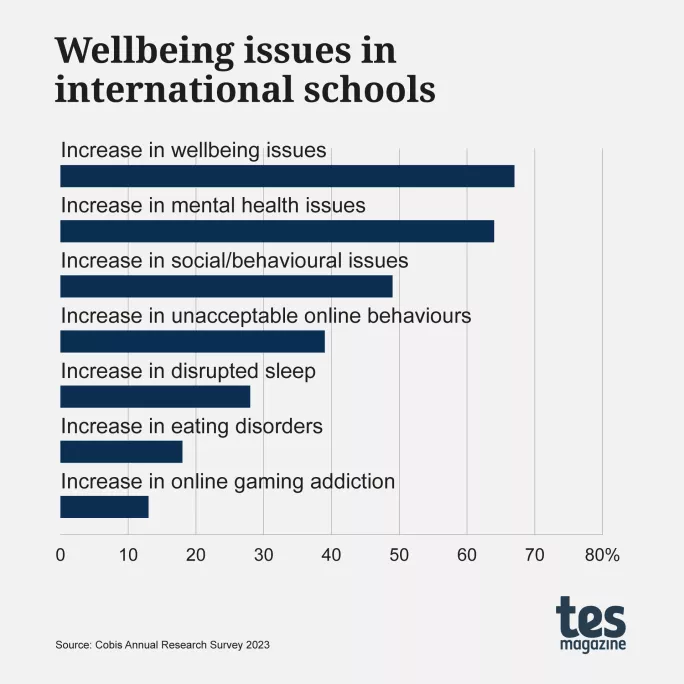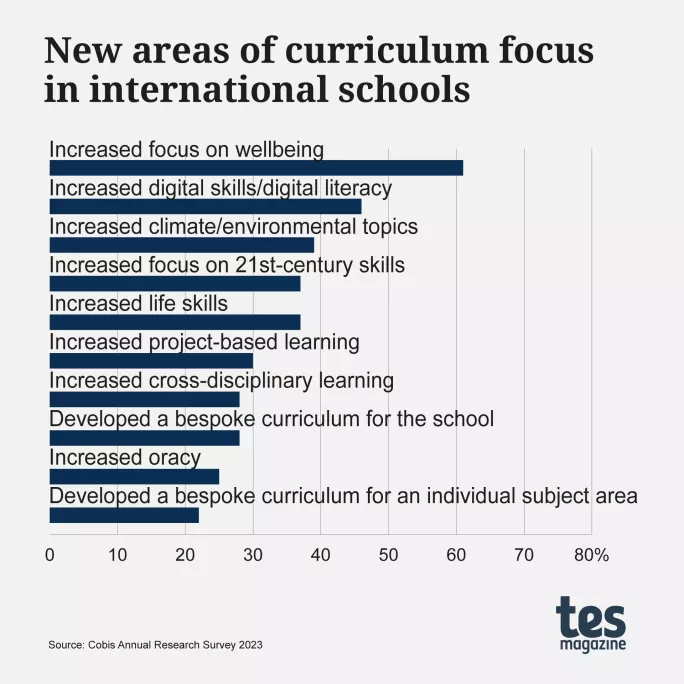- Home
- Analysis
- Specialist Sector
- Quarter of overseas schools teach ‘responsible’ AI use
Quarter of overseas schools teach ‘responsible’ AI use

A quarter of all international schools are now teaching students how to use artificial intelligence (AI) “responsibly and appropriately”, according to a new report from the Council of British International schools (Cobis).
The Cobis Annual Research Survey, based on feedback from 161 member schools worldwide, also found that 44 per cent of schools are working on plans to teach AI use in the future, underlining the rapid impact AI is having on education, which was a major theme of the Cobis conference last May.
Furthermore, 36 per cent of schools have provided training on AI to staff, 33 per cent intend to do so in the future, 18 per cent of schools have adapted homework policies in light of AI advancements and 13 per cent have developed policies on AI.

Colin Bell, chief executive of Cobis, said international schools’ focus in this area highlights the growing awareness of AI’s potential impact and a desire for schools to be ready for this.
“I suspect a lot of schools are directing staff towards training platforms they have so they can start to learn more about AI, and that means schools can make parents aware of how the school is tracking this trend,” he said.
“Governors are probably being included in more training too - so it’s all part of helping ensure the school is ready for this, and parents see that and know the child is being prepared.”
The findings echo a discussion on the Tes International Podcast last year with Daniel Jones, chief education officer at Globeducate, who revealed how his organisation was working to create policies in this area, and subsequently appointed a dedicated head of AI.
Wellbeing and safeguarding
Meanwhile, the Cobis report revealed numerous other issues that schools are facing - with progress being made in some areas while other challenges remain.
For example, 67 per cent of schools said they had seen an increase in wellbeing issues this year, down on the 70 per cent who reported the same trend last year.
Similarly, increases in social/behavioural issues were reported by 49 per cent of schools, lower than the 57 per cent who reported the same last year.
However, an increase in mental health issues was reported by 64 per cent of schools, up from 58 per cent last year, and increases in unacceptable online behaviour were reported by 39 per cent of schools, up from 30 per cent last year.
New issues highlighted in the report, including disrupted sleep, eating disorders and online gaming addiction, underline the scale of pupil safeguarding issues that schools are grappling with - which is perhaps why 87 per cent of schools said they have a member of staff with specific responsibility for wellbeing.

New curriculum focus
The report also noted that schools are making many adaptations to their teaching in an effort to tackle these topics and others pertinent to young people.
For example, 61 per cent of schools have increased their focus on wellbeing within the curriculum and 46 per cent have an increased focus on digital skills/digital literacy.
Climate education (39 per cent), “21st-century skills” (37 per cent), project-based learning (30 per cent) and oracy (25 per cent) have also risen up schools’ agendas (see table below).

Mr Bell said it was clear that schools want to offer a holistic approach. He also noted that ensuring children are future-ready is increasingly something parents expect from the international school experience.
“Oracy and critical thinking are life skills that go beyond school and into university and beyond, so schools want to be able to offer that alongside the expectation there will be a strong academic offering too,” he said.
Growing demand for staff
Despite these challenges, the sector remains buoyant, with 58 per cent of schools reporting an increase in student numbers and 24 per cent saying numbers have stayed the same, as the post-pandemic boom in international education continues.
This has been driven by expansion in nations such as India - which is now second only to China for the number of international schools - the Middle East, especially the United Arab Emirates and Saudi Arabia, and Nigeria in Africa.
This sector-wide growth has had an impact on the recruitment side too, with 46 per cent of schools saying they had recruited more teachers for the 2023-24 school year than in 2022-23.
However, demand has made competition for teachers even tougher, with a total of 91 per cent of respondents saying it is “very” or ”somewhat” challenging to “recruit the required quality of permanent teaching staff”.
Notably the data showed that both the numbers of UK nationals and local teachers in international schools had dropped, suggesting that more teachers from other nations - likely other English-speaking nations such as the US, Canada, South Africa and elsewhere - are being recruited.
The use of virtual interviews, earlier advertising of vacancies, training new teachers and the increasing use of social media to promote jobs are all on the rise as ways for schools to remain competitive in the market, the report found.
Mr Bell said this highlighted the ongoing fluctuations in the recruitment market for international schools and how they are looking to get ahead of this.
“We’re seeing some entrepreneurial schools set up their own teacher training hubs, while interest in iQTS (international qualified teacher status) pathways is also rising, with more providers licensed to deliver that, so it’s clear, as demand rises, the pressure to find more teachers is increasing too.”
Finally, the survey data revealed the extent to which international schools are now teaching large cohorts of local students, with the average school having 46 per cent of local pupils, compared with an average of 15 per cent UK nationals.
Meanwhile, the average number of nationalities in a school was 39, although one school that replied had 107 different nationalities represented - showing just how diverse the sector can be, said Mr Bell.
“The sheer scope of diversity in some schools cohorts underlines the diversity in our unity across the sector, and the vibrancy and intercultural conductivity and shared learning opportunities international schools provide.”
You need a Tes subscription to read this article
Subscribe now to read this article and get other subscriber-only content:
- Unlimited access to all Tes magazine content
- Exclusive subscriber-only stories
- Award-winning email newsletters
Already a subscriber? Log in
You need a subscription to read this article
Subscribe now to read this article and get other subscriber-only content, including:
- Unlimited access to all Tes magazine content
- Exclusive subscriber-only stories
- Award-winning email newsletters
topics in this article



